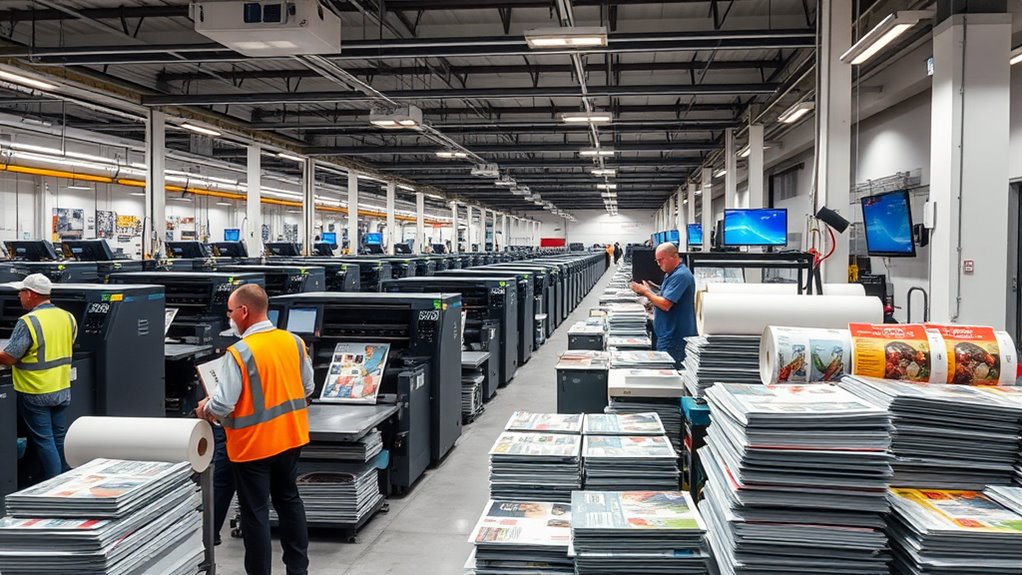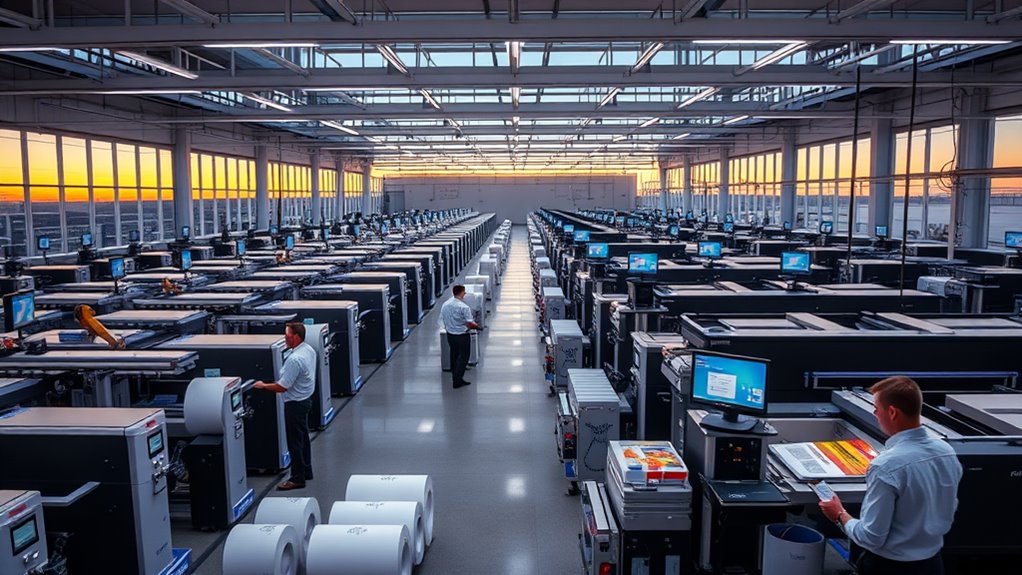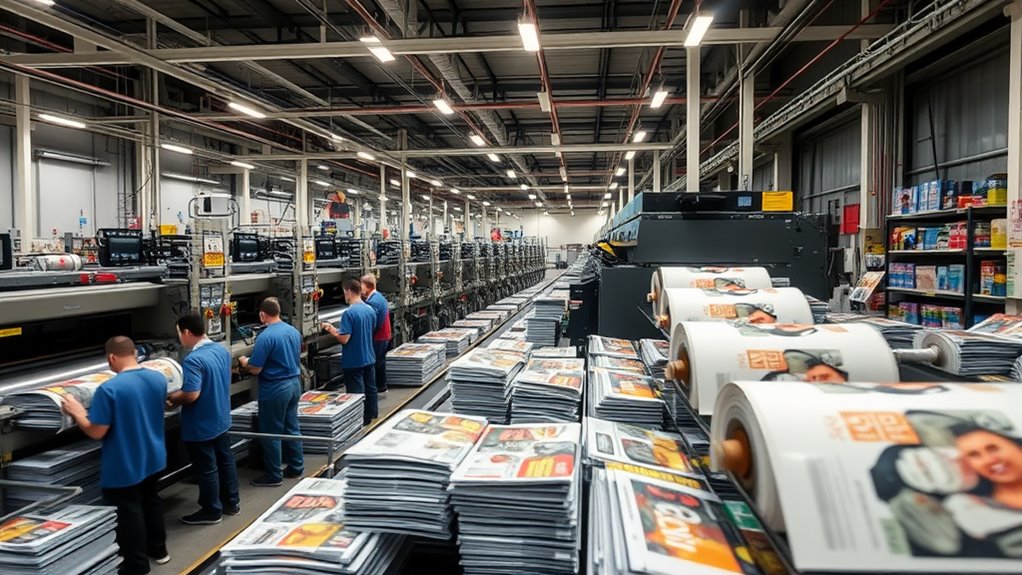Commercial printing is a massive $800+ billion global industry that serves as the foundation for all printed materials in business and marketing. You’ll find it encompasses several key segments: digital printing for quick, small runs; offset printing for large-scale projects; and specialty printing for unique applications. The industry primarily serves publishing (28%), retail/marketing (32%), corporate communications (25%), and industrial sectors (15%). Today’s commercial printers leverage advanced technology like digital presses, automated finishing systems, and AI-driven workflows to meet diverse printing needs. Understanding the different printing methods and their applications will help you make better decisions for your projects.
Key Takeaway
- Commercial printing is an $800+ billion global industry providing professional printing services for businesses, publishers, and organizations.
- The industry encompasses digital printing, offset printing, and specialty printing services for various business materials and publications.
- Major segments include publishing (28%), retail marketing (32%), corporate communications (25%), and industrial documentation (15%).
- Services range from printing books and magazines to marketing materials, business documents, and technical manuals.
- The industry combines traditional printing methods with modern digital technologies, focusing on automation and sustainable practices.
Commercial Printing Industry Overview
Printing presses across the globe form the backbone of the commercial printing industry, a sector that generates billions in annual revenue through the production of magazines, books, packaging, promotional materials, and business documents.
As you explore this dynamic industry, you’ll find it encompasses several key segments:
- Digital Printing: You’re looking at approximately 15% annual growth in this segment, with technologies like inkjet and laser printing leading innovation
- Offset Printing: You’ll still see this traditional method dominating high-volume runs
- Specialty Printing: You can access services for textiles, electronics, and 3D applications
Core Services You’ll Encounter:
- Variable data printing
- Wide-format production
- Cross-media campaigns
- On-demand printing
- Package printing
The industry’s current value exceeds $800 billion globally, and you’ll notice it’s rapidly evolving with technological advancement. You’re witnessing a transformation where traditional methods merge with digital solutions, creating hybrid workflows that boost efficiency and reduce costs. When you’re evaluating commercial printing services, you’ll find that sustainability initiatives and automated processes are becoming standard features, reflecting the industry’s adaptation to modern business needs.
Types of Commercial Printing Services
Several distinct printing services dominate today’s commercial market, each tailored to specific client needs and production requirements. You’ll find these core services available at most professional printing establishments:
Digital Printing
- Short-run jobs with quick turnaround times
- Variable data capabilities for personalization
- Cost-effective for quantities under 500 pieces
- Full-color options with minimal setup time
Offset Printing
- Traditional method ideal for large quantities
- Superior color accuracy and consistency
- Cost-effective for runs over 1,000 pieces
- Wide variety of paper stock options
Specialty Services
- Large format printing for banners and signage
- Screen printing for textiles and promotional items
- Letterpress for high-end, textured materials
- Die-cutting and finishing services
You’ll need to evaluate factors like quantity, timeline, and budget when choosing between these options. Digital printing’s becoming increasingly popular, with 52% of commercial printers now offering both digital and offset services. For your marketing materials, you might opt for digital printing’s flexibility, while you’d choose offset for your annual reports requiring consistent, high-volume runs.
Major Market Segments

Commercial print buyers fall into distinct market segments, each with unique demands and purchasing patterns. You’ll find these segments drive significant portions of the industry’s revenue and shape service offerings.
Key Market Segments:
- Publishing and Media (28% of market)
- Books, magazines, newspapers
- Corporate publications
- Digital content supplements
- Retail and Marketing (32% of market)
- Point-of-purchase displays
- Direct mail campaigns
- Product packaging
- Promotional materials
- Corporate Communications (25% of market)
- Annual reports
- Training materials
- Business forms
- Internal documents
- Industrial and Technical (15% of market)
- Product manuals
- Technical documentation
- Engineering prints
- Safety materials
You’ll notice that each segment requires different production approaches and service levels. For example, retail clients often need quick turnaround times and variable data printing, while publishing clients typically require longer runs with consistent quality standards. Understanding these segments will help you tailor your printing needs to industry-specific solutions and leverage the most appropriate technologies for your projects.
Technology and Equipment
Modern printing technology encompasses both traditional and digital equipment, revolutionizing how the industry serves its diverse market segments. You’ll find that today’s commercial printers rely on a sophisticated blend of offset presses, digital printers, and finishing equipment to meet your production needs.
The backbone of commercial printing operations includes these essential technologies:
- Digital Production Presses: You can achieve quick turnarounds with machines like the HP Indigo series, which offers print speeds up to 4,600 sheets per hour and variable data capabilities
- Offset Lithography Equipment: You’ll get superior quality for larger runs using systems that can handle sheet sizes up to 40 inches and print up to eight colors simultaneously
- Wide-Format Printers: You’re able to create everything from banners to vehicle wraps with printers that accommodate materials up to 16 feet wide
- Finishing Systems: Your projects come together with automated folders, cutters, and perfect binders that process up to 7,000 pieces per hour
You’ll notice that modern workflow automation software integrates these systems, allowing for seamless job tracking and quality control. With computer-to-plate (CTP) technology, you’re able to bypass traditional film processes, reducing production time and improving accuracy.
Growth and Future Trends

Industry projections indicate robust growth for commercial printing through 2030, driven by technological innovations and shifting market demands. You’ll find that digital printing technologies, in particular, are revolutionizing the industry with projected growth rates of 5.7% annually.
Key Growth Drivers:
- Digital transformation of traditional print processes
- Rising demand for personalized marketing materials
- Integration of AI and automation in printing workflows
- Sustainable printing practices and eco-friendly materials
Emerging Trends You Should Watch:
- Variable data printing for customized content
- Smart packaging with QR codes and NFC technology
- Print-on-demand services reducing inventory costs
- 3D printing applications in commercial markets
You’ll need to adapt to these industry changes by embracing hybrid printing solutions that combine traditional and digital methods. The market’s moving toward shorter print runs with quicker turnaround times, and you can expect to see increased demand for cross-media marketing campaigns that integrate print with digital platforms.
Future Success Factors:
- Investment in automation technologies
- Development of sustainable printing practices
- Enhanced data security measures
- Skills training in digital printing technologies
Conclusion
You’re now part of an industry that’s evolved from simple ink-on-paper to a digital powerhouse, where you’ll find yourself maneuvering between traditional offset presses and cutting-edge 3D printing solutions. Whether you’re managing direct mail campaigns or overseeing package printing, you’ve joined a sector that’s surprisingly resilient in our digital age. Don’t let anyone tell you print is dead – it’s just getting more innovative, and you’re right where the action is.









